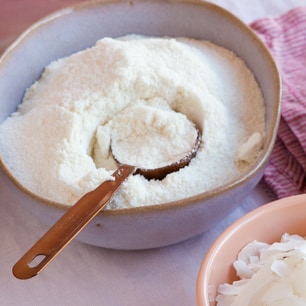Published March 1, 2021
Thanks to paleo and keto dieting, more people are going grain-free. But it’s about more than losing the gluten—a family of proteins found in some grains. A grain-free diet eliminates all grains, including wheat, oats, rice, rye, barley, triticale, buckwheat, bulgur, teff, corn, and amaranth.

Before you begin.
Many people go grain-free as a way to treat food allergies, lose weight, or live a healthier lifestyle. However, there is not enough research to support these claims. This trendy diet is typically not recommended by dietitians because it can deprive the body of key nutrients, including B vitamins, iron, magnesium, zinc, selenium, and fiber. If you are considering a grain-free diet, please consult your doctor or find a registered dietitian who can analyze your eating habits and make recommendations to ensure that you are getting the nutrients you need.
Once you’re given the grain-free green light, we have plenty of products and recipes to support your wellness journey.
Grain-free made easy.
Here are some great places to start.
- Frozen foods section: There are plenty of different breads and tortillas for sandwiches, wraps, and more.
- Snack aisle: Craving something salty and sweet? Make snacktime a success with grain-free chips, crackers, and cookies.
- Baking aisle: Mix it up with pancakes, muffins, and breads.
- Pasta aisle: Plan a dinner using bean-based pastas with more protein1 and fiber2 than traditional pasta. Our Publix Aprons® recipe for Chicken and Cauliflower Margherita Penne uses red lentil penne pasta.
Naturally grain-free foods.
Avoid grains the old-fashioned way with foods that are naturally grain-free.
- Trade breads or tortillas for lettuce leaves. We can always use more veggies.
- Riced and spiralized veggies are great substitutes for pasta and rice. Find them in the frozen and produce sections.
- Add nutritious seeds—such as flax, chia, or hemp—for a crunchy texture.
- Starchy vegetables, like potatoes, sweet potatoes, and winter squash, are great alternatives. Try our Publix Aprons® recipe for Smoky Chicken and Vegetables for an easy, all-in-one meal baked in a foil packet.
More ways to bake.
With so many grain-free flours, you’re sure to find a new favorite.
-
Almond flour, with its nutty taste, is the most well-known grain-free flour alternative. It’s denser, so you’ll need to add more leavening agents to bring a bigger rise from baked goods. Almond flour is available in two forms: blanched almond flour and natural almond flour. Blanched almond flour is made by removing almond skins before grinding them into a flour or meal. We also carry natural almond flour, made from almonds with their skins intact.
Using natural almond flour in recipes can result in coarser texture—it’s fine for scones and muffins but not recommended for cakes. You can also make your own almond flour by grinding whole or sliced almonds in a food processor until they resemble a coarse meal—a perfect breading for chicken or fish.
-
Coconut flour is dried coconut ground into a fine powder. It contains more fiber than regular flours. Due to this higher fiber content, you may need extra eggs, applesauce, water, or oil to keep the recipes moist. Remember that tip when making this recipe for Blueberry and Coconut Flour Muffins.
-
Tapioca flour, cassava flour, and arrowroot starch can also be used as grain-free alternatives. Check our stores for availability or contact the customer service desk to place special orders.
-
Become a grain-free guru with this chart. Products may vary by manufacturer, so please use the instructions on packaging or websites for best results.
| Flour | Replacement to 1 cup flour | Baking Tips |
|---|---|---|
| Almond | 1 to 1 | Dense; may need to add more leavening for more rise |
| Coconut | 1 to 3 | Add extra egg, water, oil, or applesauce for moisture; add 1 tablespoon coconut flour to 1 cup almond flour for a fluffy texture |
| Cassava | 1 to 1 | Most similar to wheat flour; slightly nutty flavor. Can be used in a variety of recipes from baked goods to sauces |
| Arrowroot | Add to coconut or almond flour to add lightness to your baked goods, substitute it for 1/4 of the recipe's flour; use as a replacement for cornstarch to thicken soups, pie fillings and sauces. | |
| Tapioca | 1 to 1 1/2 | Mix with water first before adding to your recipe to prevent clumping |
If you compare the weight of all-purpose flour to the weight of the flour you’re using, you’ll get a better result. For example, a cup of all-purpose flour weighs about 120 grams so you’ll substitute 120 grams of almond flour.
For the love of you.
Choosing how you eat is uniquely personal. It’s about your needs, your preferences, and your goals. As your wellness ally, we’re in your corner with fresh ideas, recipes, and wellness icons that make it easier to shift toward wiser food choices. It’s all about you, at your very best.
Sources
1 SmartLabel for Consumers. Publix 100% Whole Grain Penne NET WT 16 OZ (454 g). The Consumer Brands Association and Food & Consumer Products of Canada. Accessed December 11, 2020.
2 SmartLabel for Consumers. Barilla Rotini, Red Lentil NET WT 8.8 OZ (250 g). The Consumer Brands Association and Food & Consumer Products of Canada. Accessed December 4, 2020.

 You are about to leave publix.com and enter the Instacart site that they operate and control. Publix’s delivery and curbside pickup item prices are higher than item prices in physical store locations. Prices are based on data collected in store and are subject to delays and errors. Fees, tips & taxes may apply. Subject to terms & availability. Publix Liquors orders cannot be combined with grocery delivery. Drink Responsibly. Be 21. For prescription delivery, log in to your pharmacy account by using the Publix Pharmacy app or visiting
You are about to leave publix.com and enter the Instacart site that they operate and control. Publix’s delivery and curbside pickup item prices are higher than item prices in physical store locations. Prices are based on data collected in store and are subject to delays and errors. Fees, tips & taxes may apply. Subject to terms & availability. Publix Liquors orders cannot be combined with grocery delivery. Drink Responsibly. Be 21. For prescription delivery, log in to your pharmacy account by using the Publix Pharmacy app or visiting 
